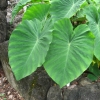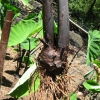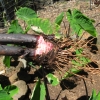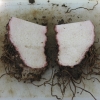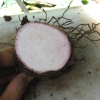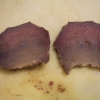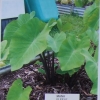Use As Food
Eaten mainly as table taro for home consumption. Makes excellent poi.
Distribution
Limited, confined chiefly to the island of Hawai‘i; planted almost exclusively under māla (upland) culture.
General Characteristics
Medium in height, erect, maturing within 9 to 12 months, producing two or three branches; as many as 6 to 7 ‘ohā from a corm, readily distinguished from other Mana by the blackish colored Hā (Petiole).
Ha (Petiole)
55 to 85 cm. long, purplish-black, pink to whitish at the lihi (stem edge), a dark reddish-purple ring at the kōhina (base) with lilac pink for 3 to 4 cm. above the base.
Lau or Lu'au(Leaf Blade)
35 to 50 cm. long, 25 to 40 cm. wide, 30 to 40 cm. from tip to base of sinus (māwae), egg-shaped (ovate), dark green; veins purplish on lower surface; round leaf section (lobes) acute with shallow lihi māwae (sinus).
'I'o kalo (Corm)
Flesh white tinged with lilac near the top (apex), with yellowish fibers; skin dark purple.
Pua (Flower)
Remarks
This variety is said to be the most drought-resistant of the Hawaiian taros.

